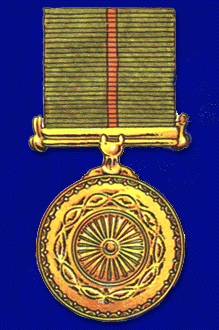Ashoka Chakra

|
|
Subsequent awards of the Ashoka Chakra are recognized by a bar to the medal ribbon (to date, none have been awarded). It is possible for a recipient to be awarded the Kirti Chakra or Shaurya Chakra in addition for separate acts of gallantry. The medal was originally established in 1952 as the "Ashoka Chakra, Class I" as the first step of a three-class sequence of non-combatant bravery decorations. In 1967, these decorations were removed from the "class-based" system and renamed as the Ashoka Charkra, Kirti Chakra, and Shaurya Chakra. This is an important point in understanding the independent Indian view of decorations. It would also lead to changes in the Padma Vibhushan series, the distinguished service medal series, the life saving medal series , and the Defence Security Corps medal series. In many ways, the Ashoka Chakra can be seen as a post-independence equivalent of the George Cross. From 1 February 1999, the central government instituted a monthly stipend for Ashoka Chakra recipients of Rs. 1400. Jammu and Kashmir awarded a cash award of Rs. 1500 (ca. 1960) for recipients of this award. Established: Established as the "Ashoka Chakra, Class I" by the President of India, 4 January 1952 (with effect from 15 August 1947). The statutes were revised and the decoration renamed on 27 January 1967. Obverse: Circular gold gilt, 1-3/8 inches in diameter. In the center, the chakra (wheel) of Ashoka, surrounded by a lotus wreath and with an ornate edge. Suspended by a straight bar suspender. The medal is named on the edge. Reverse:Blank in the center, with "Ashoka Chakra" in Hindi along the upper edge on the medal and the same name in English along the lower rim, "ASHOKA CHAKRA". On either side is a lotus design. The center is blank, perhaps with the intent that details of the award be engraved there. There is no indication of the class on the pre-1967 awards, and, in fact, there is no difference between these medals and the post-1967awards. Ribbon: 32 mm, dark green with a 2 mm central saffron stripe. Dark green 15 mm, saffron 2 mm, dark green 15 mm.
Awards:
|

 Awarded for the "most conspicuous bravery or some daring or pre-eminent valour or self-sacrifice" other than in the face of the enemy. The decoration may be awarded either to military of civilian personnel and may be awarded posthumously.
Awarded for the "most conspicuous bravery or some daring or pre-eminent valour or self-sacrifice" other than in the face of the enemy. The decoration may be awarded either to military of civilian personnel and may be awarded posthumously.